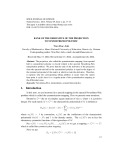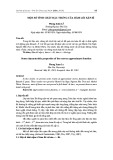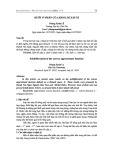
HPU2. Nat. Sci. Tech. Vol 03, issue 02 (2024), 35-45.
HPU2 Journal of Sciences:
Natural Sciences and Technology
Journal homepage: https://sj.hpu2.edu.vn
Article type: Research article
Received date: 16-02-2024 ; Revised date: 28-3-2024 ; Accepted date: 23-5-2024
This is licensed under the CC BY-NC 4.0
35
A note on the existence of solutions to the semi-affine
variational inequalities problems
Van-Dong Vu
*
Hanoi University of Industry, Hanoi, Vietnam
Abstract
The semi-affine variational inequality problem offers a general and versatile framework applicable to
many problems in economics, mathematical physics, operations research, and mathematical
programming. One of the important applications of the semi-affine variational inequality problem is
quadratic programming. It is well-known that the first-order necessary optimality condition for a
constrained optimization problem can be rewritten as a variational inequality. This paper investigates
the existence of solutions for the semi-affine variational inequality problem in the finite-dimensional
Hilbert spaces. Under suitable conditions, we show that the solution set of the semi-affine variational
inequality problem is nonempty. The obtained results contribute to and complement the existing
literature.
Keywords: Semi-affine variational inequalities, finite-dimensional Hilbert space, solution existence,
recession cone, normal cone
1. Introduction
Let
be a real finite-dimensional Hilbert space and let
K
be a nonempty closed convex set in
.
In this work, we will address the semi-affine variational inequality problem, denotes (sAVI(T,c,K)),
find
such that , 0 ,
x K
Tx c y x y K
(sAVI(T,c,K))
where
,
denotes the scalar product in
,
T
is a bounded linear operator on
and c
. The
solution set of (sAVI(T, c, K)) is denoted by Sol(sAVI(T, c, K)).
*
Corresponding author, E-mail: dongvv@haui.edu.vn
https://doi.org/10.56764/hpu2.jos.2024.3.2.35-45

HPU2. Nat. Sci. Tech. 2024, 3(2), 35-45
https://sj.hpu2.edu.vn 36
The problem (sAVI(T,c,K)) is a natural generalization of the (classical) affine variational
inequality problem, which was introduced by Tam in [1]. The generalization here is to use a convex
set in
other than the polyhedral convex set in
- the setting for the affine variational inequality
problem which has been extensively studied in [2]–[5] and references therein. Problem (sAVI(T,c,K))
also arises under optimal conditions (see e.g., [6], [7] and references therein). For the problem
(sAVI(T,c,K)) in Euclidean spaces, stability results have been explored, as discussed in [1]. These
results encompass the boundedness and stability of solutions under arbitrary perturbations of
sufficiently small magnitude. The upper and lower semicontinuity of the solution mapping were
discussed in [7] by Nghi, particularly in the case where
K
is defined by finitely many convex
quadratic constraints.
An extension of (sAVI(T,c,K)) is a problem of the form: finding an element
n
x
such that
( ) and ( ), ( ) 0, ,
G x K F x y G x y K
(1)
where , :
n n
F G
are two given continuous maps. In [8], Tam and Nghi provided results for the
existence of solutions to problem (1). However, when applied to the problem (sAVI(T,c,K)), the
conditions for the solution existence given in [8] are equivalent to assuming either the set
K
is
compact or
T
is strictly monotone. Since the semi-affine variational inequality is a subclass of
variational inequality, the solution existence results from variational inequality (see, e.g., [9]–[11] and
the references therein) can be applied to the semi-affine variational inequality. However, due to its
special structure, we can derive more consistent results for that problem. The primary objective of this
work is to establish a set of conditions under which the semi-affine variational inequality problem has
a solution.
The remainder of the paper is organized as follows. In Section 2, some notions and results which
are useful in the sequel are presented. In Section 3, we prove, under suitable conditions, the solution
set of the generalized affine variational inequality is nonempty. Section 4 presents several examples.
Finally, we conclude our paper by emphasizing the results that have been obtained.
2. Notations and preliminary results
Throughout this paper,
denotes an infinite-dimensional Hilbert space equipped with the scalar
product
,
and the induced norm
|| ||
. For a nonempty, closed, convex set K
, the recession
cone of
K
, denoted by
0
K
, is defined as:
0 { 0}.
K v x tv K x K t
∣
If K
is a nonempty set and
x clK
(the closure of
K
), then normal cone (see [12], [13]
and [14]) of
K
at
x
is given by:
( ) { , 0 for all }.
K
N x u u y x y K
∣
Definition 2.1. (cf.[15] and [16]) Let
C
be a closed convex cone in Hilbert space
and let
T
be bounded linear operator on
. We say that
(i)
T
is positive semidefinite on
C
if
, 0
Tv v
for all
v C
;
(ii)
T
is positive semidefinite plus on
C
if
T
is positive semidefinite on
C
and if
, , 0
v C Tv v
then *
( ) 0
T T v
;

HPU2. Nat. Sci. Tech. 2024, 3(2), 35-45
https://sj.hpu2.edu.vn 37
(iii)
T
is positive on
C
if
, 0
Tv v
for all
v C
,
0
v
;
(iv)
T
is coercive on
C
if there is an
0
such that
2
, || ||
Tv v v
for all
v C
.
Let
x
be a point belonging to
K
. For any number
r
, we denote,
: { || || } and : .
r
x x x r K K
∣
Lemma 2.1. Let
x
be a point belonging to
K
. The problem (sAVI(T,c,K)) has a solution if and
only if there exists some
0
r
so that the variational inequality problem r
(sAVI(T, c,K ))
has a
solution
r
x
with
|| ||
r
x x r
.
Proof. This proof is similar to the proof of [9, Theorem 4.2].
Lemma 2.2. Let
x
be a point belonging to
K
. Suppose that there exists
0
r
such that
r
K
is
nonempty set. Then,
r
x
is a solution to the variational inequality problem r
(sAVI(T, c, K ))
if and
only if, there exist some scalar
r
,
0,
r
such that
( ) ( ).
r r r k r
Tx c x x N x
(2)
Proof. We have
r
Sol(sAVI(T, c, K )) , 0
, 0
( ).
r
r r r r
r r r
r K r
x Tx c x x x K
Tx c x x x K
Tx c N x
(3)
Since (int )
r
K K
, by [17, Theorem 3.10],
( ) ( ) ( ).
r
K r r K r
N x N x N x
Hence
r
Sol(sAVI(T, c, K )) ( ) ( ) .
r r r K r
x Tx c N x N x
It is easy to check that
( ) { ( )}
r r r
N x x x
for all
0
r
. Consequently,
r
x
is a solution of
the problem r
(sAVI(T, c, K ))
if and only if there exists some scalar
0
r
such that
( ) ( )
r r r K r
Tx c x x N x
,
and the proof is complete.
Note that if condition (2) is satisfied for all
0
r
, then the (sAVI(T,c,K)) problem is uncertain to
have a solution.
Lemma 2.3. Consider the problem (sAVI(T,c,K)). Suppose that
x K
. Then,
x
is a solution to
the variational inequality problem (sAVI(T,c,K)) if and only if
( ).
K
Tx c N x
Proof. This proof is similar to the proof of Lemma 2.2.
To prove our main result, we need to use the concept of an exceptional family of elements, as
introduced by G. Isac et al. in [18].

HPU2. Nat. Sci. Tech. 2024, 3(2), 35-45
https://sj.hpu2.edu.vn 38
Definition 2.2. We say that 0
{ }
r r
x K
is an exceptional family for the variational inequality
(sAVI(T,c,K)), if the following conditions are satisfied:
(i) || || as
r
x r
,
(ii) for any
0
r
there exists a real number
0
r
such that
( ) ( ).
r r r K r
Tx c x x N x
3. Main results
In order to prove the solution existence of (sAVI(T,c,K)), we need the following lemmas.
Lemma 3.1 (cf. [19]). Let
K
be a nonempty closed convex set in
. Suppose that k
x K
for
all
k
, || ||
k
x
as k
and 1
|| ||
k k
x x
weakly converges to
v
. Then,
0 .
v K
Proof. Take any
y K
and
0
t
. We have 1
|| || || ||
k
kk k
xt
y t y K
x x
and it is clear
that
k
y
converge weakly to
tv y K
. Hence
0
v K
.
Lemma 3.2 (cf. [9]). Consider the problem (sAVI(T,c,K)) where
K
is a nonempty compact and
convex subset in
. Then, (sAVI(T,c,K)) has a solution.
The following theorem is a special case of the variational inequality. However, for the sake of
completeness, we provide the complete proof here.
Theorem 3.1. Consider the problem (sAVI(T,c,K)). Suppose that the variational inequality
problem (sAVI(T,c,K)) has no exceptional family. Then (sAVI(T,c,K)) has at least one solution.
Proof. Suppose that, contrary to our claim, the problem (sAVI(T,c,K)) has no solution. We show
that (sAVI(T,c,K)) has an exceptional family.
Taking any point, denoted as
x
, belonging to the set
K
. Since (sAVI(T,c,K)) has no solution,
by Lemma 2.1, there exists no
0
r
such that the problem r
(sAVI(T, c, K ))
has a solution
r r
x K
with
|| || .
r
x x r
It is evident that
r
K
is a nonempty, compact and convex set for each
r
. Consequently,
according to Lemma 3.2, we deduce that the problem r
(sAVI(T, c,K ))
has at least one solution.
Therefore, there exists a sequence
{ }
r
x
with the following property: For each
r
,
r
Sol(sAVI(T, c, K ))
r
x
and
|| || .
r
x x r
We next claim
{ }
r
x
is an exceptional family for (sAVI(T,c,K)). It is easy to check that
|| ||
r
x
as
r
. Since
r
Sol(VI(T, c, K ))
r
x
, by Lemma 2.2, there exists a scalar
0
r
such
that
( ) ( ).
r r r k r
Tx c x x N x
(4)

HPU2. Nat. Sci. Tech. 2024, 3(2), 35-45
https://sj.hpu2.edu.vn 39
It follows from (4) that
( )
r K r
Tx c N x
if
0
r
. Thus we deduce from Lemma 2.3 that
Sol(sAVI(T,c,K))
r
x
. This is in
contradiction with our assumption at the beginning of the proof. Consequently,
0
r
. So we have
shown that the sequence
{ }
r
x
satisfies || ||
r
x
as
r
, and for each
0
r
, there exists a
real number
0
r
such that (4) holds. By Definition 2.2,
{ }
r
x
is an exceptional family for
(sAVI(T,c,K)). This contradicts our assumption that the problem (sAVI(T,c,K)) has no exceptional
family. Hence, (sAVI(T,c,K)) has at least one solution.
The following theorem gives a sufficient condition for the solution existence of (sAVI(T,c,K)).
Theorem 3.2. Consider the problem (sAVI(T,c,K)). Suppose that
(i)
T
is positive semidefinite plus on
0
K
;
(ii) if { }
k
x K
and || ||
k
x
as k
then ,
sup 0;
|
l| ||
im
k k
k
k
Tx x
x
(iii) there exists
x K
such that
, 0
Tx c v
for all
(0 ) {0}
v K
.
Then, the set Sol(sAVI(T,c,K)) is nonempty.
Proof. Take any point
x
in
K
. For any number
r
, we denote
{ || || }
x x x r
∣
and
r
K K
.
To prove the theorem, we first show that the problem (sAVI(T,c,K)) has no exceptional family.
Suppose on the contrary that (sAVI(T,c,K)) has exceptional family. By Definition 2.2, we have that
|| ||
r
x
as
r
, and that, for each
r
, there a scalar
0
r
such that
( ) ( ).
r r r k r
Tx c x x N x
(5)
Since (5) is satisfied with
0
r
, it follows from Lemma 2.2 that for each
0
r
,
r
x
is a
solution to the variational inequality problem r
(sAVI(T, c, K ))
. As the solution set to the problem
r
(sAVI(T, c, K ))
is nonempty for each
0
r
, it follows that
, 0 0.
r r
Tx c x x r
(6)
Put 1
|| ||
k
r r
v x x
. One has
|| || 1
k
v
, then there exists a subsequence of
k
v
weakly converges to
v
. Without loss of generality we can assume that 1
|| ||
r r
x x
weakly converges to some v
as
r
. It follows from Lemma 3.1 that
0 .
v K
From (6) it follows that
, , , 0.
r r r r
Tx x Tx c x c x r
(7)
Multiplying both sides of (7) by
2
|| ||
r
x
and letting
r
we obtain

























![Quyển ghi Xác suất và Thống kê [chuẩn nhất]](https://cdn.tailieu.vn/images/document/thumbnail/2025/20251030/anh26012006/135x160/68811762164229.jpg)
